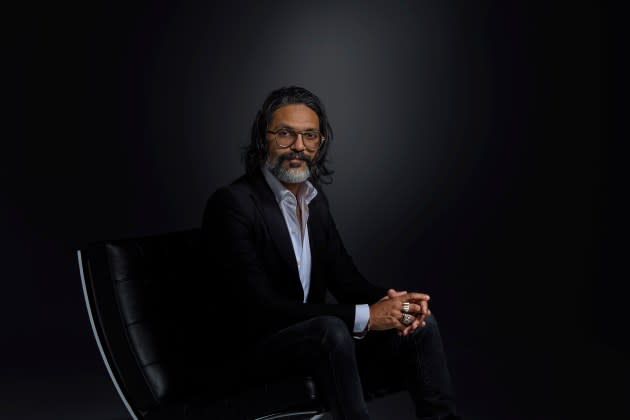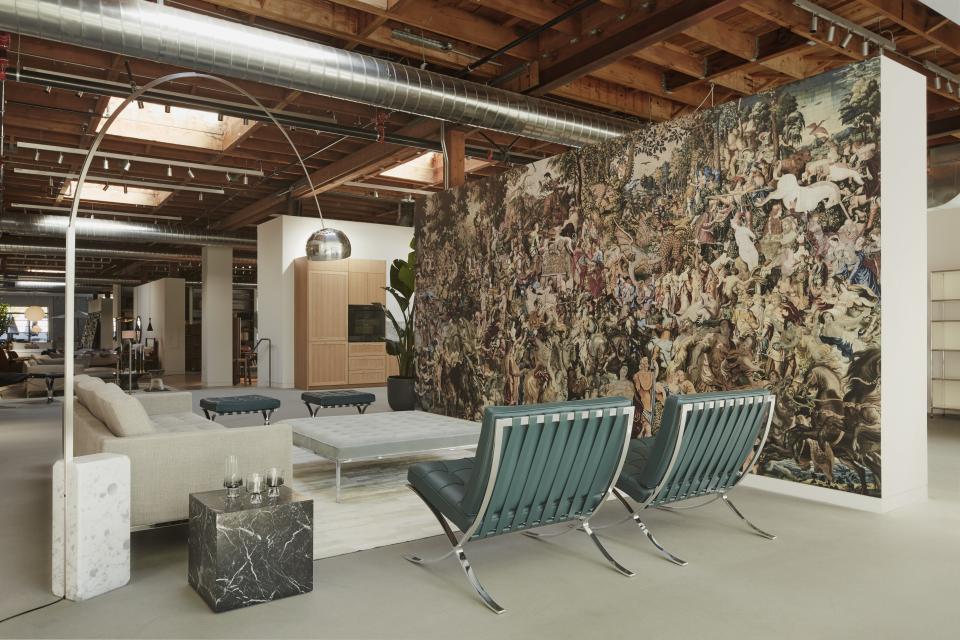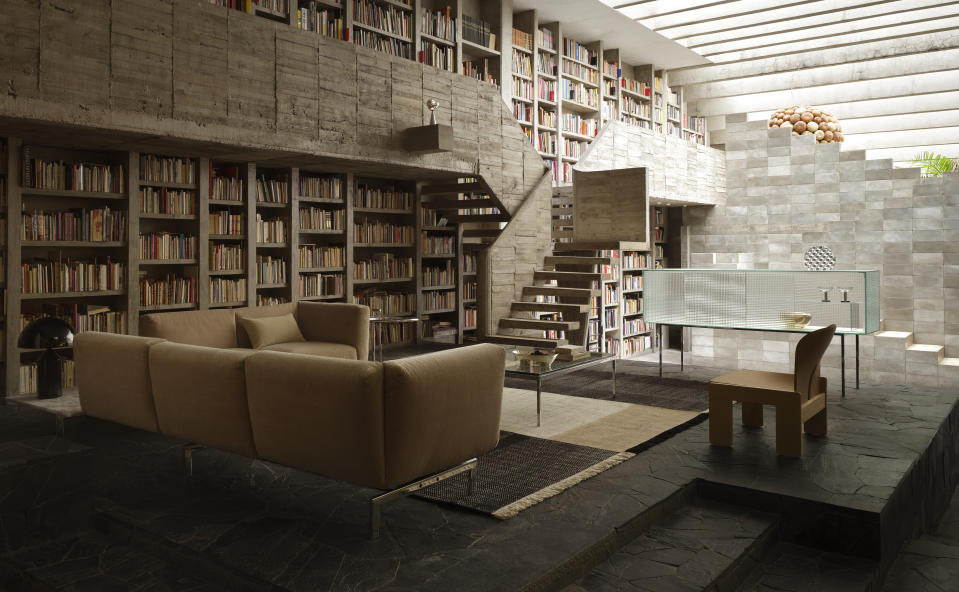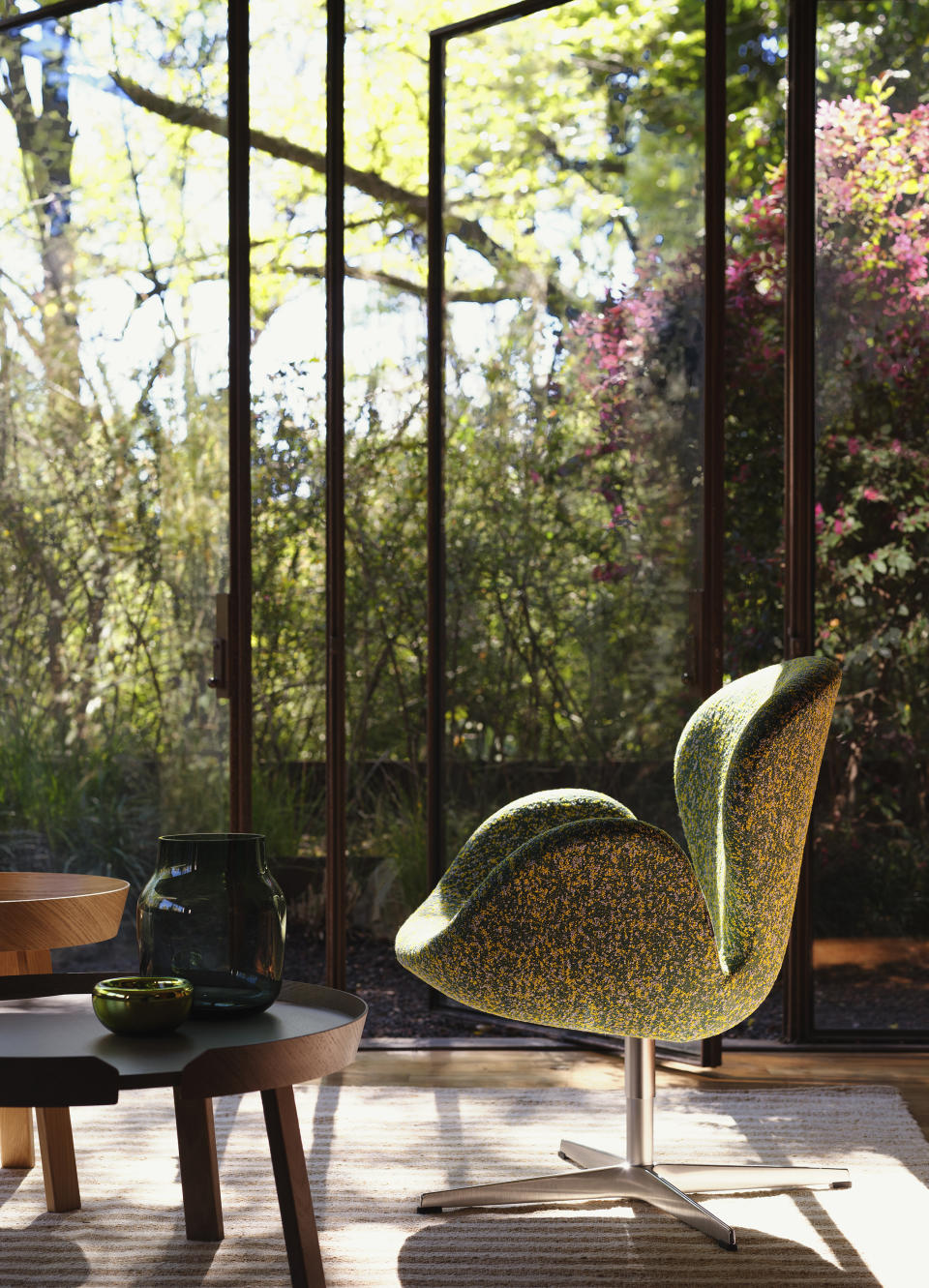Omar Nobil on Transforming Design Within Reach From a Retail Store to a Lifestyle Brand

“This industry has been extremely welcoming and non-judgmental of a fashion guy moving in,” says Omar Nobil, vice president and creative director of Design Within Reach. He’s sitting in a conference room — in a black leather Eames Aluminum Group Chair (a classic) — at the Design Within Reach offices in New York City. Nobil, 45, joined DWR in October 2022 after nearly two decades in the fashion industry, most recently as head of women’s design at Banana Republic.
His goal is to harness the power of the MillerKnoll-owned DWR’s status as a modern design retail mecca and keeper of icons (from the Eames lounge chair and ottoman to the Saarinen dining table) into a full-fledged lifestyle brand.
More from WWD
How Kartell Democratized High-end Design, Starting with a Plastic Chair
Parisian Gallerist Emmanuel Perrotin on Taking a Page From Fashion's Playbook
“There is a tendency in the industrial design world to be very product-centric,” he says. “The fashion industry is very uninhibited in declaring that they are lifestyle brands when, essentially, they do very few products for the home. For me, that grounding in fashion means that you are thinking about a person’s entire life.”
Founded in 1999, Design Within Reach is almost singlehandedly responsible for the mass education of American consumers in the modern design aesthetic. Before DWR, icons of the modernist movement were locked away in designer showrooms — a proverbial velvet rope preventing U.S. customers from outfitting their homes with the sublime creations of Le Corbusier or Mies van der Rohe or Isamu Noguchi.
“When I came to this country,” says Nobil, who grew up in London and arrived in America in 2005, “it was the first time I was able to get up close and personal to a Barcelona chair, or an Eames lounge and ottoman or a Womb chair without feeling intimidated by sales staff in a European showroom.”
Nobil sees the potential to convert a new generation of modern design enthusiasts the way he was converted. One way to do that is to think in terms of function, and how people interact within spaces, instead of simply focusing on chairs, sofas and sideboards.
“I have found that it really helps to have this kind of radical empathy for who you’re designing for as opposed to just designing on the continuum of modern design,” he adds. “It feels like a very new approach within how this industry has operated.”
His strategy enfranchises emerging and established designers. It’s the antithesis of DWR’s rocky earlier foray into a “lifestyle” expansion. Several years after going public in 2004, DWR executives rushed headlong into a series of ill-advised brand offshoots including DWR Kitchen, DWR Bath and a home accessory shop — called Tools for Living — that sold everything from cheese slicers to garden shovels. More deleterious to its reputation, though, was a cost-saving scheme that replaced many of its stalwart furniture products with knockoffs that engendered a handful of IP infringement lawsuits and much ill will in the design community. (Herman Miller acquired DWR in 2015, before merging with Knoll in 2021 to become MillerKnoll.)
“I do see this role as being a custodian of the brand,” adds Nobil. “Outside of standing for original design, outside of being a trustworthy source of authentic design, we really want to feed the design industry by inspiring the next generation of designers.”
To that end he has piloted the company’s first in-house design studio, which is at work on several new products set to come online in the next couple of years. And in late January, the company debuted a new flagship in San Francisco — the birthplace of the brand — that emphasizes an experiential approach to the retail showroom. Encompassing 15,000 square feet in a converted 1920s-era factory (it once housed the California Caster & Hand Truck Company) in the city’s Potrero Hill district, it is Nobil’s first brick-and-mortar reimagining since joining the company.
The new DWR San Francisco studio showcases interactive exhibits, launches and exclusive collaborations and includes two capacious rotating display areas — the Gallery and the Case Study Apartment. The inaugural Gallery installment is dedicated to the work of French architect Jean Prouvé, curated by Swiss furniture company Vitra, and includes historical texts and material samples. For the Case Study Apartment, DWR commissioned Swiss design and manufacturing brand USM to create several unique configurations (including a bed, dresser and closet system) of its USM Haller Collection. The Case Study Apartment is imagined as the live-work space for a “fictional Beat poet,” explains Nobil.

The entire studio is purposefully specific to the cultural history of the Bay Area with a reading room with books from famed bookstore City Lights and a Linge Rosset Togo sectional seating area with headphones and turntables and records from Haight Street’s Amoeba Music featuring recordings from the Bay Area progressive music scene. (Nobil is an audiophile; he has a custom-built valve amp record player. “It’s a very warm sound and it pairs very well with the kind of music I listen to, which is music from real instruments, like jazz and blues.”)
The studio also includes the first curated installation of large-scale Digital Projects, high-resolution, museum-quality digital prints (meant to be used as wall coverings), from textile manufacturer Maharam that feature emerging and established artists, photographers, illustrators, and fashion and graphic designers.
“It is very much a platform for us to show modern design as a true lifestyle,” he says. “I think that’s the biggest part of our evolution as a brand since I’ve joined; how do we shift the perception of us as a true lifestyle brand, with a point of view on lifestyle, as opposed to just a series of historic icons that everyone is extremely reverential toward? That work was underway when I joined, but my job has been narrowing and focusing that and bringing it together in a way that is aspirational. We wanted to really show how you live with these amazing icons. We want you to use them, we want you to sit in your Eames lounge and ottoman, essentially wear it and pass it to your kids, and they can pass on to their kids.”
It’s a philosophy that is deliberately paradoxical to the environmentally catastrophic fast furniture trend. And Nobil is an avowed minimalist, with a Buddhist-like detachment to material possessions. Asked to name a prized piece of modern furniture in his own home — which he shares with his fiancée Erika Stahlman, a designer and architect, and their dogs — he mentions two Lc2 chairs purchased when they were living in Marin County, north of San Francisco, while Nobil was head of women’s design at Banana Republic. (They now make their home in Stamford, Conn.)
“We live in a very stripped-down, pared-down way and our furniture is very specific to the home that we’re living in,” he says. “Neither of us attaches a huge amount of sentiment to the vast majority of things.”
In other ways, Nobil’s approach echoes the founding ethos of Rob Forbes, a ceramicist, Stanford MBA and cultural omnivore, who wove storytelling into the modern design retail experience.
Forbes started DWR in 1998, at the dawn of the internet retail age, purchasing 20 containers full of modern design furniture, setting up a website and mailing out 239,984 copies of a catalogue. He also penned a blog, where he wrote about the creative inspiration behind modern design as well as his musings on travel, food and his love of motorcycles.
Nobil also has reimagined the quarterly Design Within Reach Journal from a rote furniture catalogue to something meant to feel more like a locale-specific design magazine by elevating the styling and photography.
There are odes to the classics (the Whiskey chair, designed by Finn Juhl in 1948; Mies van der Rohe’s Barcelona chair, designed for the German Pavilion at Barcelona’s 1929 International Exhibition) and dispatches on architecture (Thomas Gluck’s energy-efficient Catskill’s Tower House; the Los Angeles Case Study Houses created between the 1940s and ’60s; architect Tomas Osinski’s Invisible House, designed for film producer Chris Hanley in Palm Springs). The spring 2024 issue includes a Q&A with Jerald Cooper (creator of the Instagram-based cultural archive @hoodmidcenturymodern, which explores Black modernism) and Gail Kennard, the daughter of architect Robert Kennard, who is now president of her father’s L.A.-based Kennard Design Group.
“One thing that Design Within Reach and a lot of brands have done in the past is put a little bit too much emphasis on [showing every] detail of the product,” says Adrian Gaut, a fine-art and commercial photographer who has shot on numerous locations for Design Within Reach Journal.
“That merchant-driven approach to the photography starts to chip away at the authenticity of the image. Omar is making a very conscious decision to move away from that. The conversation that we had before we started the first big project was, how do you make things look sexy, but also not look like you’re trying to sell it?”

The Summer 2024 issue includes Gaut’s photos of the home designed by architect and sculptor Pedro Reyes in Mexico City’s Coyoacán neighborhood as well as Casa Erasto, a dramatic stack of angular glass and concrete on the edge of the verdant Chapultepec forest. The summer issue also will mark the exclusive release of Arne Jacobsen’s Swan and Egg chairs (designed in 1958 for the SAS Royal Hotel in Copenhagen and manufactured by Fritz Hansen) in Raf Simons’ Atom fabric, which Simons designed for Danish textile manufacturer Kvadrat. A version of the Swan chair is staged at Casa Erasto, where it’s paired with the Muuto Outline sofa and Around coffee tables.
Simons released his fabric collaboration with Kvadrat in January 2014, during his fall 2014 menswear collection in collaboration with artist Sterling Ruby. The fabrics were also featured in Simons’ 2015 and 2016 fall collections and at Christian Dior couture and ready-to-wear shows in 2014 and 2015. The Swan and Egg chairs are exclusive to DWR and available in three color combinations of the Atom pattern, which is a bouclé fabric inspired by the pointillist paintings of the Expressionist movement. (In 2021, DWR released Juhl’s Series 77 chair in a selection of Raf Simons-Kvadrat fabrics.)
“Fabric expansions,” says Nobil, offer an opportunity to evolve DWR’s iconic designs. He cites artist Nick Cave’s fabric collection with Knoll Textiles — released in late 2022 — as another example. The fabric was used to create 12 limited-edition Knoll chairs, unveiled at last year’s NYCXDesign and auctioned, with proceeds benefitting’ Cave’s Facility Foundation, which provides scholarships for emerging artists. The latest Raf Simons-Kvadrat project is an intuitive reimagining of a classic, which, given Simons’ reverential status in the fashion and industrial design sectors, is also likely to be a hit with midcentury aficionados as well.

“I worked on endless collaborations in my [fashion career], from luxury designers to celebrities,” says Nobil. “There is a lot of heavy lifting doing that work, but it can also be really fun. It gives you a chance to bring in new audiences. But the collaborations that we choose have to be aligned with our values as a brand. We want to work with thought leaders who are thinking about life today and life in the future, and are really relevant and contemporary to their time. We would never rush into a collaboration purely for exposure.”
Of course Nobil does come from the most status-conscious sector of the design world. The fashion industry’s capriciousness can be implacable. And Nobil’s rise at Banana Republic, part of Gap Inc., coincided with the withering of the midrange mall brands as online shopping supplanted in-real-life store browsing. His tenure was marked by several well-received collections and notable collaborations, including with style influencer Olivia Palermo. But by the time the pandemic set in, he found himself at a psychic fork in the career road. Nobil and Stahlman were living in Tiburon in Marin County, just north of San Francisco. (They met on a dating app in 2017; their first date was at the Odeon in TriBeCa.) Nobil was working remotely and Stahlman, whose architecture firm is based in New York, was in the midst of construction on a Brooklyn town house.
“I was leading a design team of about 40 people and trying to work through all of the challenges that [the pandemic] put in front of us and how to transition the brand, stay ahead of consumer needs,” recalls Nobil. “And Erika was traveling back and forth during one of the most daunting periods of time. We had this very intense year, but we spent a lot of time with each other.”
They had ample outdoor space, but the exponential increase in screen time had a stultifying effect and Nobil took refuge in Stahlman’s library of architecture and design books. “You know that point in the pandemic where you sort of got to the end of the internet? I just felt like, ‘OK, I’ve seen everything that there is to see online,’” he says.
They began to talk about working on a project together. And in the spring of 2021, Nobil resigned from his position at Banana Republic to focus on the project with Stahlman. “I was a precursor to the great resignation,” he says. “It just felt to me that if I don’t do this now, I’m going to be [at Banana Republic] for the next 10 years.”
The result was a 3,200-square-foot, $12 million Brutalist spec house in the middle of the Joshua Tree high desert (they purchased a three-acre lot in the area in 2021). The futuristic cylindrical concrete three-bedroom home looks like something from the early “Mad Max” films, minus the apocalyptic overtones. It includes 180-foot windows, an environmentally responsible mineral-water pool, concrete kitchen countertops, a built-in concrete-and-glass dining room table, and a primary bedroom suite with a walk-in closet stocked with 21 outfits in monochrome gray tones custom-designed by Nobil.
“For me, it was about just challenging myself creatively and thinking outside of just clothes. We did it because we were yearning for complete creative freedom.”
Discovering Fashion in Dad’s Closet
The son of Pakistani immigrant parents, Nobil’s interest in fashion was sparked early on by his father’s collection of suits from the ’60s and ’70s. “My dad’s wardrobe was a big influence on me,” he says. “Particularly the stuff he’d bought before he had kids; English-made tailoring but very high-quality manufacturing, classic and traditional, things that you hold on to.”
His father, a dentist, immigrated to London in 1958, the same year as the first military coup in Pakistan. Nobil’s mother is Rukhsana Ahmad, a well-known novelist and playwright; she arrived in 1972, after marrying Nobil’s father. His siblings are also writers; his sister Aamina Ahmad is a novelist and playwright and his brother Ali Nobil Ahmad is a researcher and journalist. The family settled in central London, not far from the fashionable shopping district of Brompton Cross.
“It was a very traditional Georgian town house in central London, and my parents, both first-generation immigrants, came from a generation that got lots of crystal and china as wedding presents. We had very traditional furniture, a bunch of built-ins, lots of books.
“Coincidentally, we were less than a quarter of a mile from The Conran Shop [the furniture brand established in 1972 by influential British designer Sir Terence Conran]. It was a very design-centric neighborhood; you’d have these very cutting-edge modern design brands literally at the top of our street. We had this very traditional home; my parents have very classic taste. They still have all the same furniture that’s moved with them every home, good quality products. Not my aesthetic but very much bringing integrity through the quality.”
By the time he was a young teen, Nobil was wearing his father’s suits and nurturing a distinct interest in fashion. Today, his uniform of choice is a tailored black jacket over a dress shirt, usually in either black or white, unbuttoned below the neck, and chunky silver rings and cuffs.
“In the interior design architecture space, he’s towards the more flamboyant side sartorially,” laughs Gaut. “When we met I was like, ‘Who’s this guy in all black with all the jewelry?’ But he’s such a sweet guy. I definitely ribbed him about it, but he was very good-spirited about it. I remember being in a taxi with him in Mexico during the last shoot and [The Rolling Stones’] ‘Paint It Black’ came on. He’s like, ‘Oh, this is my favorite karaoke song.’ I was like, ‘Wow, that’s really not a surprise. That is very on character.'”
Nobil attended London’s Central Saint Martins college, where he earned an undergraduate degree and then found work in fashion PR and special projects for British designer Hussein Chalayan. But what he really wanted to do was design, and so he returned to CSM, enrolling in the master’s degree fashion design program. For his graduate fashion show in 2004, as part of London Fashion Week, he sent models down the runway in tailored, almost militaristic, suits, dresses and coats in a minimalist beige and white color palette.
A job on the design team at Abercrombie & Fitch in Ohio first brought him to the U.S. in 2005, and in 2006, he joined Banana Republic, moving to New York City and working his way up at the company. By January 2018, after 12 years at Banana Republic, he was named head of women’s design. He cut a distinctive figure at the Gap offices.
“I would see him in the cafeteria,” says Anouar Alami, who is now vice president of global licensing at Tory Burch. “He was always sharply dressed. When we actually started working together, I recognized his passion for creativity and how he instills and fosters it in others.”
Scouting trips abroad would invariably include a full menu of museums and gallery visits, recalls Alami. “That was something that stood out to me, especially working in a massive company that was very calendar-driven. We had a lot of deadlines, so it can feel very structured. He always made the space for creative thinking.”
Nobil also developed his egalitarian management style at Banana Republic, where former colleagues say he rejected hierarchical systems that can often stymie creativity. For Nobil, a good idea can come from anywhere and an appreciation of great design should cross genres. For the “fashion guy” at the country’s foremost modern design retail destination, it would be a fitting legacy.
“The love for design is the great equalizer,” says Nobil. “Whether you’re talking to a household-name billionaire or a design student who’s just bought their first Bertoia chair, maybe vintage. These are conversations I’ve had in the last year since joining. It’s coming from a place of joy and passion for really great modern design. It’s not coming from a place of desiring status.”


